Fun formula or why we play games
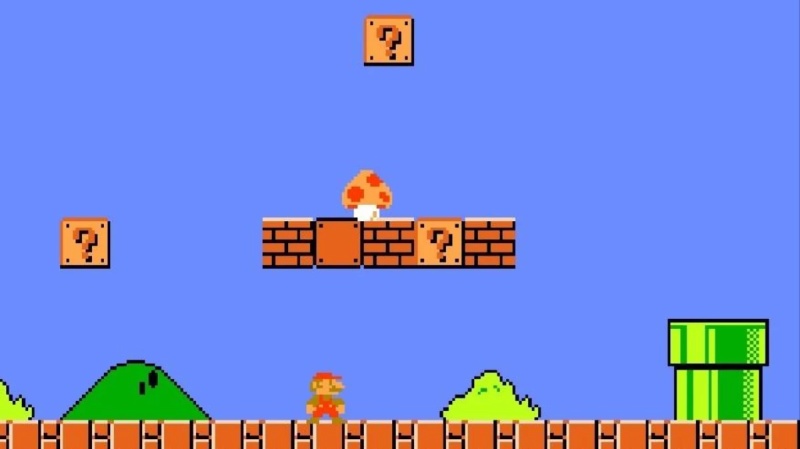
Warning: it is possible to reduce the pleasure of games and films, as there will be awareness and understanding of how they work.
Somehow I wanted to make a game and I had questions.
Why do we play? What elements of the game do we get a fan of?
')
Further, the word "fan" means positive emotions.
Search on the Internet did not give an exact answer. Someone writes that players like to do what they can't in the real world. Others write that the plot is important. According to such descriptions do not make a good game.
Since I have been interested in neuropsychology for a long time, I understood that there is something at the lowest level of the brain that makes us play games.
I decided to conduct thought experiments discarding all unnecessary from games to determine the minimum set of elements for which there is still a fan, but if you remove at least one element of the game, the fan disappears or is not so strong anymore.
Having done this experiment with the games in which I played, I got this set of basic elements:
- Purpose.
- Last action
- The estimated probability of achieving the goal is less than 100%.
- Time of uncertainty.
- The resolution of the situation - achieved or not the goal.
Most games have consistent goals. That is, to go through the game to the end it is necessary to overcome intermediate levels. Inside these levels it is necessary to overcome micro obstacles.
For all of these goals, from global to microscopic, there is this basic set of calling fan. Because of what we continue to play the game.
Consider everyone understandable game Mario
She has the main goal to go to the end, kill the boss and save the princess. Also, there is a division into levels.
But the most interesting thing is micro obstacles that need to be overcome mostly only by jumping. This is usually called the game mechanics.
When we jump over an opponent or a pit, we do it like this:
- Define the goal: fly over the pit.
- Last action: press the jump button.
- The probability of achieving the goal: whether we can jump over the pit.
- Time of uncertainty: flight.
- Result: landed or fell into a hole.
Brain and uncertainty
The fact is that the brain calculates all our actions a little in advance.
As long as the forecast is 100 percent predictable, then everything is fine and there is no tension.
But when the prognosis is not accurate, and there is only some probability of achieving the goal, tension arises in the brain. That is, an attempt to simultaneously predict several outcomes.

The brain is difficult to be in this uncertainty. He needs a discharge on one result.
A transition from the state of "uncertainty" back to the normal mode of "certainty" is necessary. And sometimes, it does not even matter what the result, the main thing is that it is, just to relieve tension.
Time uncertainty
Also an important parameter. The longer the uncertainty is, the greater the tension. But there is a nuance. If the time of uncertainty is very large, then the brain will not withstand the tension and surrender. The voltage will disappear. And the result will no longer be important.
By pressing the jump button, the brain has already predicted the likelihood of flying over a hole and the fact that otherwise there will be an unpleasant loss.
For example, after pressing the jump, the brain predicted the probability of reaching about 70%, a time of uncertainty passes, and as a result, Mario flies.
Fan = (F +) is the area of the upper part of the graph of light green color. There is a fan, but not strong:
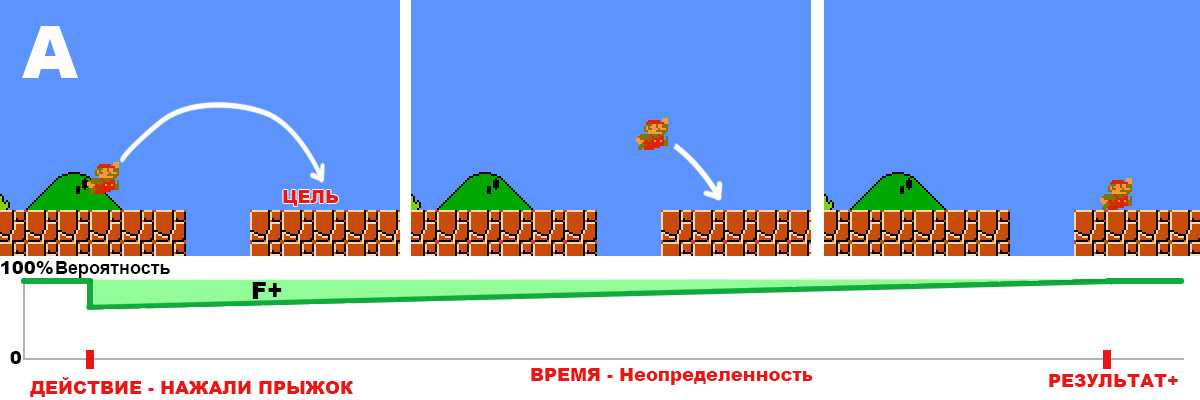
And if the positive outlook was only 5%, and Mario still managed to fly, then the fan will be much more:
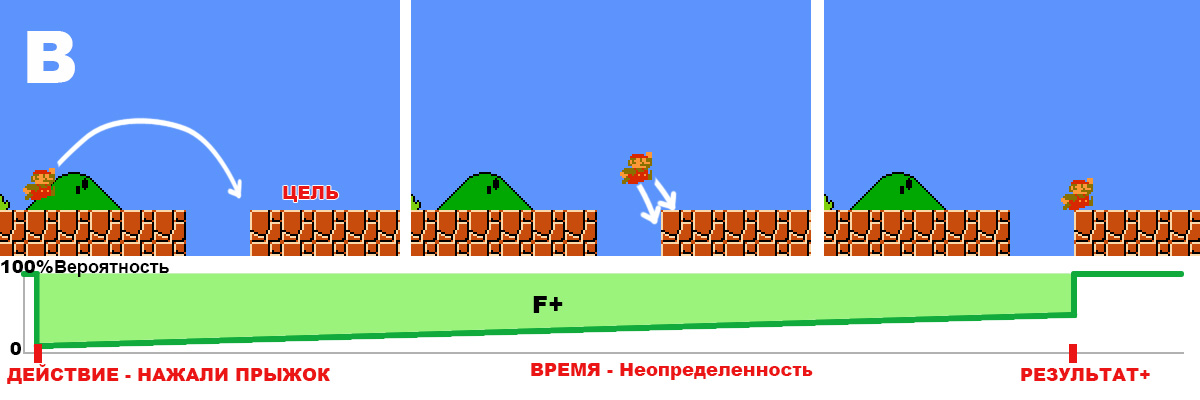
And if Mario falls into a pit, then we experience unpleasant emotions. (F-) area of the lower part of the graph:
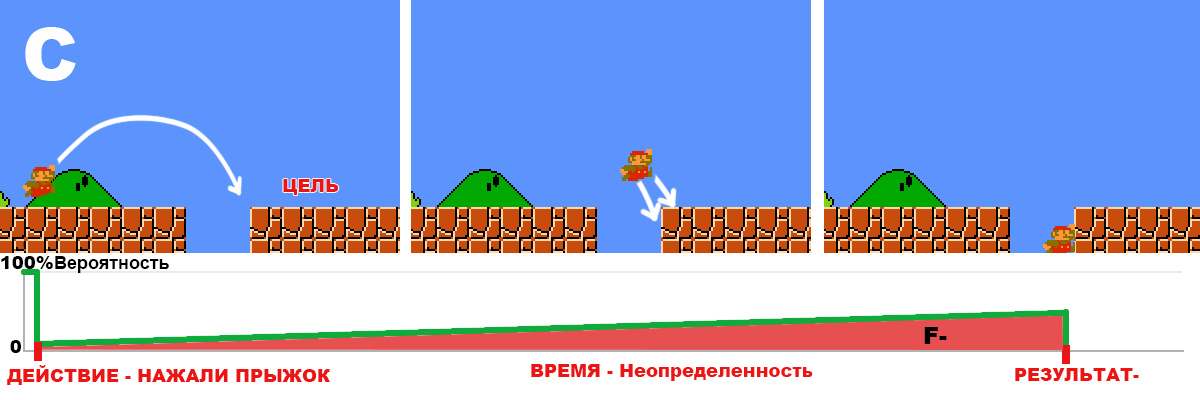
Note. Sometimes in games, during the stage of uncertainty, you can adjust your action a little. In the game Mario is a small control in flight.
Thus we get:
The more unlikely goal is achieved, the person will experience more fun.
Replayability
To make the game replayable, it is necessary that the player never was able to achieve 100% winnings. If the result depends only on the skill, then the player will eventually learn to play perfectly. This can be seen in the example of fast ideal games, where reflexes are maximized.
Therefore, in order to replay the game many times, it is necessary to add random parameters.
Shooters
The goal is usually always clear.
The time of uncertainty in a shooter is from the moment when you saw the enemy and you start aiming to the moment when the shots are fired and he is killed, or the player is killed.

In online shooters, if a player could always kill him when aiming at the enemy, then only players who by nature had a faster reaction would win.
To prevent this from happening, and other players had a chance to win, the developers enter random parameters. That is, they are trying in every way to make the game worse for those who have brought their skills to the limit. For example, add a strong variation of bullets when moving or firing a queue.
"Royal Battle"
It seems that playing against a large number of players the chances of winning tend to zero, because of this very strong and long tension from uncertainty to the very end of the game. But in case of victory, the fan rolls over.
Casual games
For example, in the “hidden objects” genre, the time of uncertainty is the time from the start of the task, which object to find, until the moment when they found and clicked on it.
Why the classic quests are almost extinct
They often do not understand the purpose of what to find and where. There is a tension from uncertainty at first, but you quickly get tired of looking for a pixel item by hunting. The time for searching is very large, and as we have already said, the brain does not withstand long-term stress and gives up.
I myself was a fan of classic quests and sometimes I searched for the right item for several days. There were no clues and therefore it was incredibly difficult to complete these quests until the end and more often the players simply gave up.
In general, if you take any game genre and carefully analyze the mechanics, then we can always find the main elements of the fan.
Lutboksy
Luthbox principle is the same. The goal is to win something rare. We press and wait for the time of uncertainty, tension arises. Usually, time is specially delayed, something is spinning or a counter is being displayed. As a result, the player receives a prize, from which he or frustration or joy.
Why in modern games less fun, but more people play
The probability of losing is specifically done less, because of this, the tension decreases and more people can withstand it. But for the same reason, the fan is also reduced.
It often happens that after passing such games, there is even nothing to remember. Since there was almost no voltage.
Screen life
Usually in games, to determine the likelihood of a player, they introduce a measure of standard of living and depict it on a large screen.
This is a very important element of the game! You look at what you have left 2 hp and try to kill the enemy. The brain predicts the probability of victory is very low, even if the player has a good skill. But the fun with such a small number of lives will be much more, if you still manage to win.
Surprisingly, even big companies are wrong.
See, BATTLEFIELD 3 - there is no scale of lives. BATTLEFIELD 5 - the scale of lives is back!
Call of Duty: Black Ops 2 and Call of Duty: WW2

What then is the right game
This is a game in which we can not always overcome obstacles from the first time. But as soon as it becomes easy for us and the main thing is to be predictable (learning has taken place and a reflex has been developed), then the complexity should increase. And further on increasing.
Let's think of a simple game right now.
We need a mechanic that has all the basic elements, for example:
- We have a ball and we have to throw it in the basket.
- There is an action button. The longer you hold the button, the stronger the ball takes off.
- The probability of hitting is not 100%. The basket is not big.
- The flight time of the ball.
- The result of hitting the ball in the basket.
Start playing! Throw. Throw. Throw. But.
After some time, we realize that there is a fan at first, but then it disappears, as we learned to hit with 100% probability.

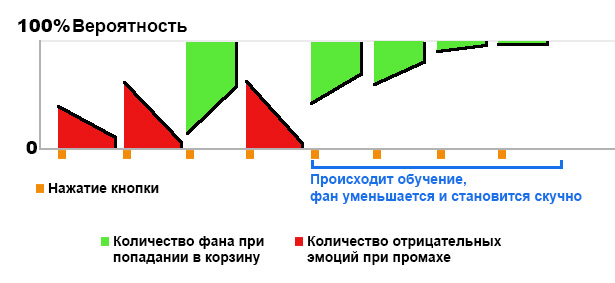
We need to change the mechanics of the game so that the probability of hitting is always less than 100%.
For example, we will gradually move the basket away from the start of the ball's flight.
(Sometimes probability elements are added to games.)




When a player learns to get across the screen. You can add other obstacles. Wind, birds, etc.
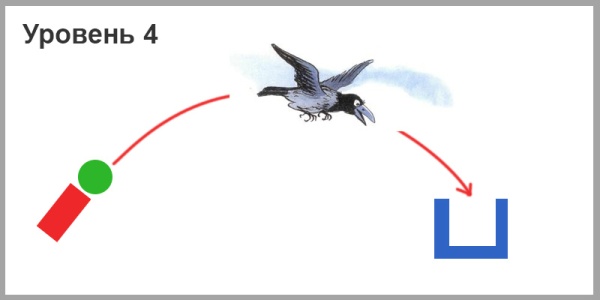
The most difficult thing is to polish all the parameters in the game so that the person continuously receives the maximum fan and does not roll everything into a routine.
Where else can this be applied
As it turned out, this is applicable in the entire entertainment industry and in general human life. Gambling, sports, movies, etc.
Sport

Kick - flight time - hit (or not).
Movie
All movie plots are built on the same principle. There is a goal that must be achieved. After 2-3 turns of the plot, the probability of reaching the goal is constantly reduced. This increases stress. In the last minutes of the film, the probability is shown close to zero (usually the hero seems to be dying and suddenly comes to life) And here comes an incredible victory. And the viewer is experiencing a fan.
The film finale is often very delayed to increase the time of uncertainty. Used time dilation.

A special plot can be distinguished ingenious film "The Beginning" of Nolan. In it, one probability is built into another and so several times. There is a multiplication of probabilities.
Inside one dream, another dream is built in and there is another one in it. The probability of a positive outcome tends to zero. Too many factors affect the outcome.
The maximum effect of the film occurs when the result of the action is life or death.
For example, the movie "Thirteen" about Russian roulette.
Slot machines and gambling
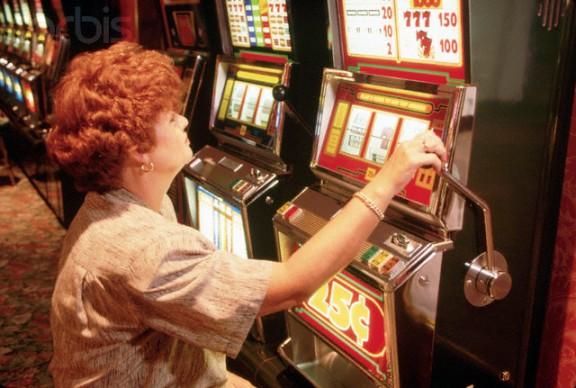
Pull the lever - wait for the time of uncertainty - the result.
Youtube, Instagram, tapes are different
- Headline that touches.
- Stress from uncertainty, what is written or shown there?
- We click - we look at the result.
All this is very similar to the experiment with the mouse, which enjoyed pressing the lever. But the man came up with how to do this without implanting electrodes into the brain.
Source: https://habr.com/ru/post/433388/
All Articles